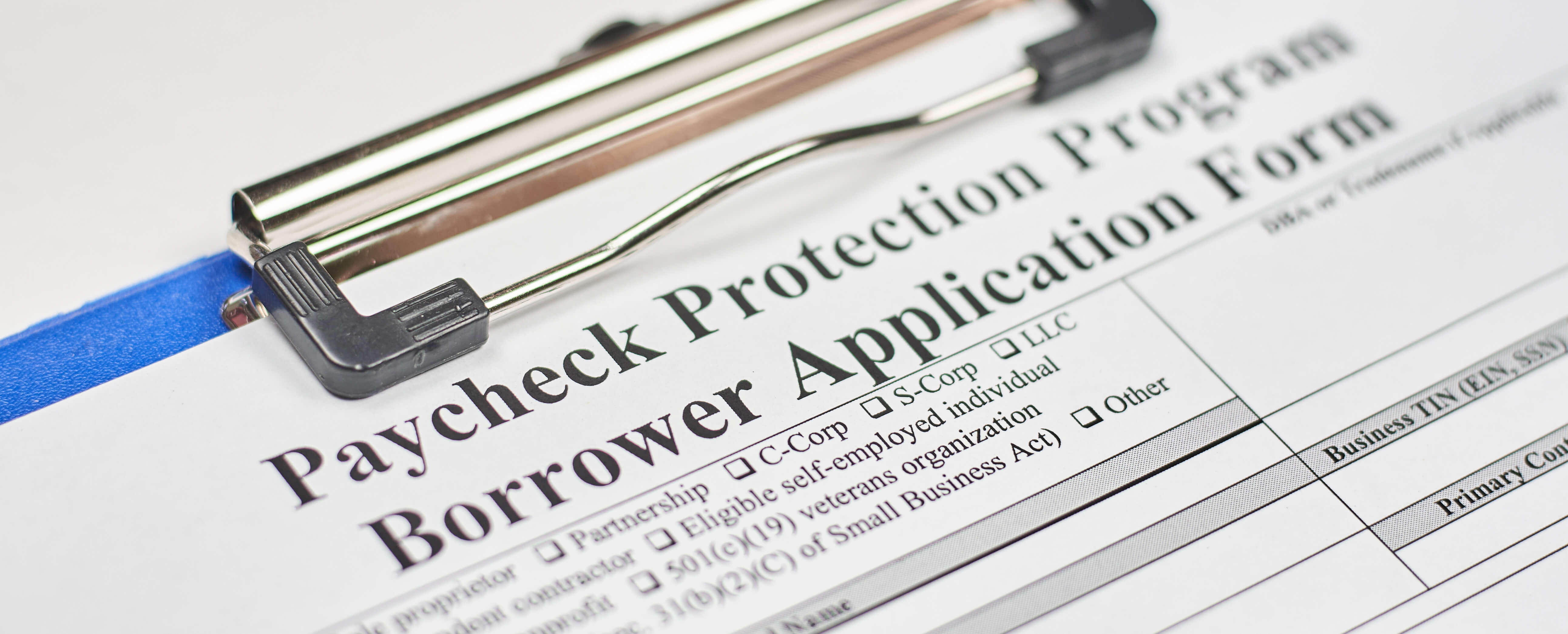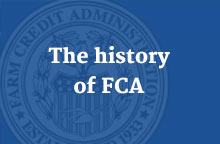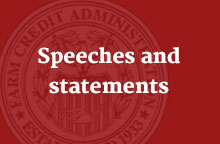
Paycheck Protection Program
This page provides information about the Paycheck Protection Program and guidance for Farm Credit System institutions for making loans under the program. We will regularly update this page with additional information and guidance, so please refer to it frequently. The date below indicates the last time an update was made to the page.
The page includes guidance from a July 14 informational memorandum (PDF) (which updated and superseded guidance issued on April 7) and a June 4 informational memorandum supplement (PDF) on regulatory capital requirements for PPP loans and PPP loans pledged to the PPP Liquidity Facility. It also contains guidance provided in a document titled Supplement to the FCA Informational Memorandum on the Paycheck Protection Program (PDF).
If a System institution has any questions on this guidance, please reach out to the examiner-in-charge for the institution.
Guidance for Farm Credit System institutions
-
On March 27, 2020, the President signed the Coronavirus Aid, Relief, and Economic Security Act (the CARES Act (PDF)) to provide emergency assistance and health care response for individuals, families, and businesses affected by the COVID-19 pandemic. The PPP, which was implemented by the U.S. Small Business Administration (SBA) with support from the U.S. Department of the Treasury, originally authorized up to $349 billion in forgivable loans to small businesses to support payroll and certain other needs during the COVID-19 pandemic. The Paycheck Protection Program and Health Care Enhancement Act, which was enacted on April 24, increased the commitment for the PPP program to $659 billion in forgivable loans.
On June 5, the Paycheck Protection Program Flexibility Act of 2020 was passed to amend the SBA Act and the CARES Act to modify certain provisions related to forgiveness of loans and to allow recipients of loan forgiveness under the PPP to defer payroll taxes. The “covered period” during which borrowers may distribute the loan funds has been extended to 24 weeks from the date of origination or December 31, 2020, whichever occurs first.
Farm Credit System institutions are eligible to participate in the PPP. System institutions that are already approved SBA 7(a) lenders are automatically approved to make PPP loans. All other System institutions will be eligible as they are approved and enrolled in the program.
-
Starting April 3, 2020, small businesses and sole proprietorships can apply for and receive loans to cover their payroll and certain other expenses through existing SBA lenders.
Starting April 10, 2020, independent contractors and self-employed individuals can apply for and receive loans to cover their payroll and certain other expenses through existing SBA lenders.
Any eligible borrower can apply through any participating System institution. All loan terms will be the same for everyone.
-
The loan amounts will be forgiven provided the following conditions are met:
- The loan proceeds are used to cover payroll costs, as well as most mortgage interest, rent, and utility costs, over the 24-week period after the loan is made.
- Employee and compensation levels are maintained.
Loan forgiveness can be provided if the employer maintains or quickly rehires employees and maintains salary levels. Under the CARES Act, loan forgiveness could be reduced if full-time headcount declines or if salaries and wages decrease. However, according to the PPP Flexibility Act, loan forgiveness will not be reduced for these reasons provided the borrowers can document any of the following conditions:
- They are unable to rehire individuals who were employees on February 15, 2020.
- They cannot hire similarly qualified employees to fill those positions by December 31, 2020.
- They are unable to restore business operations to February 15, 2020, levels because of pandemic-related operating restrictions.
Payroll costs are still capped at $100,000 on an annualized basis for each employee. However, the percentages that must be used for loan forgiveness have been amended. Under amendments made by the PPP Flexibility Act of 2020, the minimum percentage of the loan that must be used for payroll costs to receive loan forgiveness has been reduced from 75% to 60%.
Also, as explained on page 8 of the SBA’s revisions to its first interim final rule (PDF), the SBA administrator, in consultation with the Treasury secretary, has interpreted the 60% minimum “as a proportional limit on nonpayroll costs as a share of the borrower’s loan forgiveness amount, rather than as a threshold for receiving any loan forgiveness.”
In other words, if a borrower uses less than 60% of the loan on payroll costs, he or she can still receive forgiveness on a portion of the loan. For example, if the borrower receives a $100,000 PPP loan and spends $54,000 of the loan (or 54%, which is 90% of the 60% minimum) on payroll costs, the maximum loan forgiveness he or she can receive is $90,000 (that is, $54,000 in payroll costs plus $36,000 (or 36%, which is 90% of the 40% maximum) in nonpayroll costs).
Loan payments, including principal, interest, and fees, are now deferred until the date the lender receives the loan forgiveness amount from the SBA.
-
All businesses with 500 or fewer employees may apply, including the following:
- Nonprofits
- Veterans’ organizations
- Tribal business concerns
- Sole proprietorships
- Self-employed individuals
- Independent contractors
Businesses in certain industries can have more than 500 employees if they meet applicable SBA employee-based size standards for those industries. For more information, see Size standards on the SBA website. We encourage each System institution to closely review size standards because many industries that the System finances are subject to more flexible size standards or use annual receipts. (See 13 CFR § 121.201.)
Guidance continues to be forthcoming from both SBA and the Treasury Department. To ensure that any PPP loans made meet program requirements, the System institution should carefully review the following resources:
- The Paycheck Protection Program page on the SBA’s website
- The CARES Act Provides Assistance to Small Businesses, a page on the Treasury Department’s website
- The SBA’s interim final rule (PDF) announcing the PPP
- The SBA’s revisions to its first interim final rule (PDF)
To properly underwrite PPP loans, it is critical for each institution to understand in detail the requirements and obligations of this program, given its unique nature. Failure to follow SBA guidelines and limits could cause difficulties in obtaining SBA loan forgiveness, which could result in losses to the institution.
-
Yes. The PPP provides an opportunity for System lenders to access SBA’s loan guarantee and loan forgiveness authorities for covered loans related to payroll and certain other expenses of certain small businesses. The PPP has defined a small business to include agricultural operations.
The legislative and regulatory provisions that authorize the PPP do not change the lending authorities and requirements in the Farm Credit Act and FCA regulations (except as noted in the supplement (PDF) to this informational memorandum and in the supplement on regulatory capital for PPP loans and PPP loans pledged to the PPP Liquidity Facility (PDF)). For example, capital requirements (other than those addressed in the supplements) and requirements governing loan and borrower eligibility, territorial concurrence, and borrower rights, which are not specifically addressed in the legislation authorizing the PPP, still apply to the PPP loans made by System institutions.
We have also determined that our regulations are functionally equivalent to the Bank Secrecy Act and its implementing regulations for purposes of § 3(a)(iii)(II) of SBA’s PPP interim final rule.
In addition, any loan made under the PPP would be risk-weighted at 0% under FCA’s capital framework. For more information, see the supplement on regulatory capital requirements mentioned above.
Note: Section 7(a)(36)(O) of the Small Business Act as amended by section 1102(a) of the CARES Act (15 U.S.C. 636(a)(36)(O)) requires that PPP loans be risk-weighted at 0% under risk-based capital requirements. In a May 28 notational vote, the FCA board adopted the 0% risk weight for PPP loans using its authority under 12 CFR § 628.1(d)(3). See the June 11 news release.
-
FCA has reviewed the Paycheck Protection Program (PPP) set forth in section 1102 of the Coronavirus Aid, Relief, and Economic Security Act (the CARES Act (PDF), P.L. 113–116), the U.S. Small Business Administration’s (SBA) related interim final rule (PDF), and applicable guidance and forms provided by Treasury and SBA, and has determined that statutory borrower stock required in section 4.3A of the Farm Credit Act of 1971 does not apply to new borrowers from a System institution with respect to loans disbursed through the PPP.
FCA believes this determination implements the clear intent of the CARES Act to minimize costs (including fees) and that a lender will receive no direct benefit from the borrower for making a PPP loan (other than the stated interest rate). In addition, the interim final rule prescribes the same loan terms for all PPP loans. Requiring the purchase of stock is inconsistent with the program and the interim final rule.
PPP borrowers who do not acquire stock will not be eligible to receive patronage or vote in institution affairs. If a new PPP borrower engages in any other lending or membership activity of the System institution, the borrower must hold statutory borrower stock, as with any other credit or related service.
Note: The statutory minimum borrower stock requirement under section 4.3A of the Farm Credit Act of 1971 is $1,000 or 2% of the loan amount, whichever is less.
-
System institutions may extend credit under the PPP loan program to applicants who are eligible to receive financing under the Farm Credit Act and FCA regulations. System institutions may consider a PPP loan as either addressing a direct financing need or an “other credit need” of an eligible borrower, consistent with previously provided FCA guidance.
-
Yes, an applicant must waive the right to distressed loan restructuring, the right to credit reviews, and the right of first refusal to receive a PPP loan from a System institution. Normally applicants cannot be required to waive these rights in exchange for a loan from the System, but the unique structure of PPP loans means a System institution cannot offer a PPP loan without the waiver. System institutions should therefore explain to applicants that PPP financing cannot be extended without the written waiver.
See FCA regulation 617.7010(b), which explains how to waive these rights for loans guaranteed by the SBA under the 7(a) loan guarantee program, which covers PPP loans.
The waiver should not be part of the loan contract itself because the terms and conditions of the contract are controlled by the SBA. Instead, the waiver may be either entirely separate or incorporated into other loan notice and disclosure documents (as long at the borrower signs the waiver language section).
We encourage institutions to inform borrowers that SBA guarantees offer similar borrower protections as those being waived.
-
Yes, section 8.9 of the Farm Credit Act requires institutions to give borrowers advance written notice if their loans will be pooled and sold to the secondary market. They must also inform the borrowers that the sale of their loans will result in a loss of certain borrower rights. This information must be separate from other information on loan terms and conditions, but not necessarily in a separate document.
The notice must also inform the borrower that, within three days of a loan commitment, the borrower has the right to refuse the sale of his or her loan into the secondary market.
-
Yes, consistent with the second question above, System institutions may extend credit under the PPP loan program to applicants who are eligible to receive financing under the Farm Credit Act and FCA regulations. While existing FCA guidance on eligibility and scope of financing requires the full- or part-time farmer-owner to sign as an obligor on the other business loan, the CARES Act (PDF) and the SBA’s related interim final rule (PDF) do not allow for personal guarantees. Therefore, FCA does not require full- or part-time farmers to cosign or guarantee PPP loans.
This exception applies only to PPP loans. Under FCA regulations 12 C.F.R. §613.3005, “loans to farmers shall be on an increasingly conservative basis as the emphasis moves away from the full-time bona fide farmer to the point where agricultural needs only will be financed for the applicant whose business is essentially other than farming.”
Furthermore, FCA does not require the full- or part-time farmer to have an existing lending relationship with the System institution. The full- or part-time farmer, either directly or indirectly, must own the majority (i.e., 50% or greater) interest of the entity being financed. This applies whether or not the farmer is already a borrower of the institution. This guidance again applies only to PPP loans.
When a System institution makes a PPP loan using this guidance, the institution must certify in the loan file that the PPP loan meets all other FCA requirements for eligibility and scope of financing.
-
First, the institution should notify its FCA examiner-in-charge if it is participating, or plans to participate, in the PPP.
Second, the institution should complete the questionnaire we have developed to collect information on each institution’s PPP lending activities. Lending activities represent the total volume and number of loans that the institution has approved and closed. Total volume reported would be the sum of the principal amount of all PPP notes.
FCA’s chief data officer sent out the first PPP questionnaire on Friday, April 17, along with instructions for completing and submitting it. This questionnaire covered PPP loans made and closed from April 6 to 17. Originally, we had asked to receive responses to this questionnaire by April 30 (that is, within 14 days of issuing it), but we have since extended the deadline for the first questionnaire to May 7.
To reduce the reporting burden associated with PPP reporting, FCA is extending the reporting period covered in the sixth and all subsequent questionnaires from two to four weeks. The sixth questionnaire, which will cover PPP loans made and closed from June 13 to July 10, was sent on July 7 and will be due by close of business July 24. Questionnaires will be due within 14 days after the covered reporting period ends.
The following information will be collected in the PPP questionnaire:
- Number and volume of PPP loans originated to new borrowers
- Number and volume of PPP loans originated to existing borrowers
Number and volume of PPP loans closed will be collected by loan type. A PPP loan is made through the borrower’s eligibility to receive financing from a System institution. Therefore, the loan type assigned to a PPP loan should be consistent with the loan type that the borrower would receive if he or she were receiving a similar non-PPP loan.
We would expect that PPP loans made to a bona fide farmer or rancher (under § 613.3000) would be reported under the “production and intermediate term” loan type (even if the PPP loan is to an existing borrower who currently only has a real estate mortgage loan).
Below is an example of the reporting template:
Loan Type Number of Loans Volume of Loans Real Estate Mortgage Production and Intermediate Term Farm-Related Business Processing and Marketing Cooperatives Communication Energy Water/Waste Disposal Rural Residents Other
-
Probably. Based on the SBA’s draft interim final rule, a lender may make a PPP loan to one of its directors only when the director owns less than a 30% equity interest in that lender and when the same loan process is followed for any of the lender’s similarly situated customers or accountholders. The SBA strictly prohibits prioritizing a director’s application or reducing the processing time for a director’s application.
Therefore, a System association may make a PPP loan to one of its directors as long as the director currently owns no more than 30% of the association’s equity and the loan is provided in a similar manner as other PPP loans made by the association. FCA recognizes that a situation in which a director holds equity of 30% or more in a System institution is unlikely to arise.
-
To provide liquidity to small business lenders and the broader credit markets and to help stabilize the financial system, the Federal Reserve Board has created the PPPL Facility using its authority under section 13(3) of the Federal Reserve Act. Under this lending facility, the Federal Reserve Banks will extend nonrecourse loans to institutions that are eligible to make PPP loans.
Only PPP loans that are guaranteed by the SBA under the PPP with respect to both principal and interest and that are originated by an eligible institution may be pledged as collateral to the Federal Reserve Banks (eligible collateral). (Any such loans pledged to the PPPL Facility cannot be included in a System bank’s collateral that is required by section 4.3(c) of the Farm Credit Act.)
On April 30, 2020, the Federal Reserve Board expanded access to the PPPL Facility to all SBA-qualified lenders, including System institutions (see Paycheck Protection Program Liquidity Facility Term Sheet (PDF)). System institutions that participate in the PPPL Facility should ensure they fully understand the requirements, terms, and conditions of the facility.
For more information about the PPPL Facility, see the Frequently Asked Questions on the Federal Reserve’s website.
-
Any loan made under the PPP should be risk-weighted at 0% in our risk-based capital calculations. (The FCA board adopted the 0% risk weight for PPP loans using its authority under § 628.1(d)(3).) This treatment is consistent with the CARES Act mandate for the risk-based regulatory capital calculations of depository institutions. (See 15 U.S.C. 636(a)(36)(O).)
Any PPP loan that is not pledged to the PPPL Facility should be included in total average assets for purposes of the tier 1 leverage ratio calculation.
When preparing call reports, System institutions should include PPP loan amounts on schedule RC-R.7 (average balances), line 5.a (retail exposures), column D (0%).
-
PPP loans pledged to the PPPL Facility should be risk-weighted at 0% for risk-based capital measures and excluded from total average assets for leverage ratio computations. This treatment applies only to the System institution holding the PPP loan on its balance sheet. This means that, if a System association makes a PPP loan and then pledges it to the PPPL Facility, only that association may exclude the pledged loan from its leverage ratio. There will be an impact on the funding bank’s regulatory capital ratios only if the association uses the PPPL proceeds to reduce its direct loan from the bank.
When a System institution originates a PPP loan, the loan is an asset on its balance sheet and must therefore be capitalized. If a System institution participates in the PPPL Facility, it pledges the PPP loan to the facility and in return receives cash from the facility, but the pledged PPP loan must still be capitalized by the System institution. In other words, the institution must capitalize both the cash it receives from the PPPL Facility and the PPP loan that was pledged, resulting in an increase in the institution’s capital requirements.
While a PPP loan would receive a 0% risk weight and cash would generally receive a 0% risk weight for the purposes of FCA’s risk-based capital ratios, both cash and the PPP loan would be included in total average assets for FCA’s tier 1 leverage ratio calculation.
The FCA board used its authority under § 628.1(d)(4) to exclude the effects of these pledged PPP loans from System institutions’ leverage ratio calculation (including the unallocated retained earnings (URE) and URE equivalents measure). As a result, System institutions may exclude any PPP loan pledged to the PPPL Facility from its tier 1 leverage ratio. This is consistent with the treatment prescribed by the federal banking regulatory agencies in the interim final rule published at 85 FR 20387 (corrected at 85 FR 22009).
When preparing call reports, System institutions may include the PPP loan amounts pledged to the PPPL Facility on schedule RC-R.5 (miscellaneous tier 1/tier 2 calculations), line 1.c (less: other adjustments required by FCA). Including these loan amounts here removes the impact of loans pledged to the PPPL Facility on total average assets for the leverage ratio.



